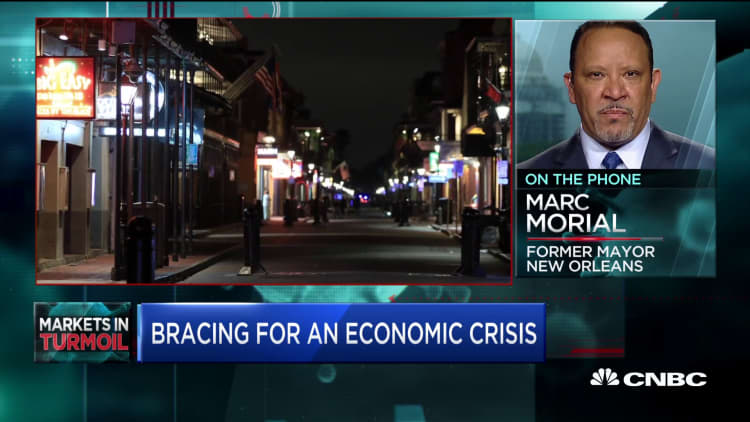With people across the country stuck indoors as the coronavirus spreads, they're turning to video calls to chat with friends, family members, colleagues, classmates and customers. There are any number of free services at their disposal, but Zoom is increasingly the one they're choosing.
Zoom sits atop Apple's rankings of the most popular free apps in dozens of countries, according to data from analytics company App Annie. Investors love it, at least for the moment. The stock sells for 58 times revenue, compared to a price-to-sales ratio of 8 for Microsoft, and it's gained 26% since Feb. 19, while the S&P 500 has plunged 32% over that stretch.
"It's interesting how quickly it's become a verb in Silicon Valley," Jonathan Heiliger, a general partner at Vertex Ventures, which has offices in San Francisco and Palo Alto, California, told CNBC on Thursday. He and his colleagues keep in touch on Zoom.
Recently people have also tuned in to weddings, bar mitzvahs and meditation sessions on Zoom. School teachers, musicians and yoga instructors are using it, as are universities, which have gone remote since COVID-19 became a global crisis.
Reliable and easy to use
The question is: Why Zoom?
Zoom is known for its reliability, avoiding long outages that discourage repeated use, and it doesn't have the latency that makes some services painful for extended conversations.
Unlike Apple's FaceTime for iOS, Zoom is also available on Android and on any laptop. It's also designed to make IT departments comfortable, and people can start video calls for free, as long as they're kept under 40 minutes and below 100 participants.
There are also features designed for fun. When you use Zoom, you can upload a picture or a video to create a virtual background. It's so popular that on Thursday Microsoft said it's adding a similar tool to its Teams service.
Zoom founder and CEO Eric Yuan has been lauded for the company's efforts to help out schools and other organizations during the crisis. On March 13, Zoom started removing the 40-minute call limit for free accounts at tens of thousands of schools in the U.S. and other countries.

"The usability and the reliability of Zoom is what has led to this incredible adoption, combined with, honestly, the generosity of Eric and his willingness to open it up especially to the schools," Zoom CFO Kelly Steckelberg told CNBC on a Zoom call earlier this week.
Yuan and Steckelberg previously worked together at Webex, a video-calling software company that Cisco acquired in 2007. People have also flocked to Webex in record numbers in the past few weeks. But Zoom is getting all the buzz, even against large competitors like GoToMeeting and Skype as well as Google Hangouts and Microsoft Teams.
One advantage to Zoom is that it only makes video-calling products, and has focused on making sure people like them.
"People love the experience more and recommend it to others," said Christoph Janz, co-founder and managing partner at Point Nine Capital.
The Berlin-based venture firm previously used Skype for meetings, but for the past few years has counted on Zoom, Janz said. Zoom offers higher video quality and fewer interruptions and a better overall experience, he said, adding that he spends five hours per day or more on Zoom.
"It has this crazy huge mind share in our circles, but I think there is still huge room to grow in the broader economy," Janz said.
One of the firm's portfolio companies, Oslo-based Confrere, makes video calling software that Norwegian doctors have been using to meet virtually with patients. Ida Aalen, a co-founder of the start-up and its chief product officer, said she uses Zoom to communicate with Janz.
"They've done some clever things with their video engineering to make sure sound and video work well even when people have very unstable connections," Aalen said. She's critical of the user interface and isn't a fan of all the buttons, colors and advanced settings.
"But when I'm in the call, it's going to work," she said. "And I have to admit, that's the core of it."



